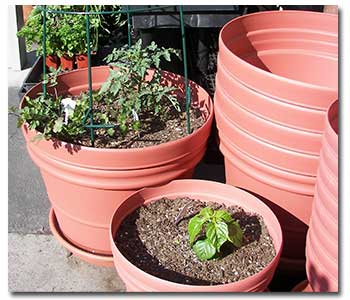Growing Veggies in Containers

Do you want the fresh taste of home grown vegetables, but don’t live on a farm? All is not lost. Container gardening has become very popular in recent years; many city-dwellers are becoming part-time farmers. The good news: Most vegetables grow well in containers!
As with real estate, container gardening is all about Location, Location, Location. Most vegetables prefer at least six hours of sun per day, but do be careful with air circulation and overheating. Space permitting, put your garden on a table or cart rather than on a cement patio; this keeps the containers from absorbing extra heat which damages your plants.
Choosing the right container is easy. The basics: the correct size for the plant and drainage holes for excess water. Plastic containers (5 gallon buckets with holes drilled in the bottom) make perfect garden containers. So do large flowerpots; however, porous terra-cotta means more frequent watering. Avoid dark colored containers as they hold heat and may overheat your plants.
Wooden containers are popular, but make sure the wood isn’t treated! The chemicals used leach into your plants. Container size is at least 10” wide by 12” deep, though some vining plants fare better in containers that are 20” or more across. For better results, you should trellis vining plants; this keeps the plants from overtaking your limited space.
Soil is just as important as location; ask your local nursery for potting soil designed specifically for containers. Gardner & Bloome® Eden Valley® Potting Soil is a premium potting soil made for pots. Or, you can make your own, using a mixture of peat moss, potting soil, vermiculite, perlite, or sand. Fill containers to within 1-2” of the rim and water the soil thoroughly; let it sit for several hours to drain before planting.
Whether seed or seedlings, use the same timetable as you would for a traditional garden. If you’re planting seed, plant more than you think you’ll need; not all seeds will grow and you can thin them later. Plant transplants at the same depth they were in their original pot. The only exception is for tomato plants; you can strip off the bottom-most leaves and plant them deeper in the container. Watering is important! You may even want to install a drip-irrigation system, speak with the experts at Grangetto’s for more information. About a month after planting, you can feed your plants with a good organic fertilizer such as Dr. Earth® Tomato and Vegetable Food. Follow the instructions on the label.
Alas, there’s no escaping weeding. It’s likely to be less of a problem with a container garden, but you still need to remove weeds and check for pests. One benefit is that container gardens are less susceptible to diseases normally found in average garden soil.
Now comes the fun – Harvest Time! A good rule is to harvest when your veggies reach a size you find appealing. However, it’s best to harvest early and often to encourage your plants to produce more. Also, vegetables that grow too large tend to lose some flavor.
Nothing lasts forever; after harvest, simply empty your containers – plants and all – into your compost. It’s tempting to reuse the soil from one season to the next, but you risk transferring infections and infestations. Wash containers with a mixture of one part bleach to 10 parts water, rinse, and store for the next season.











